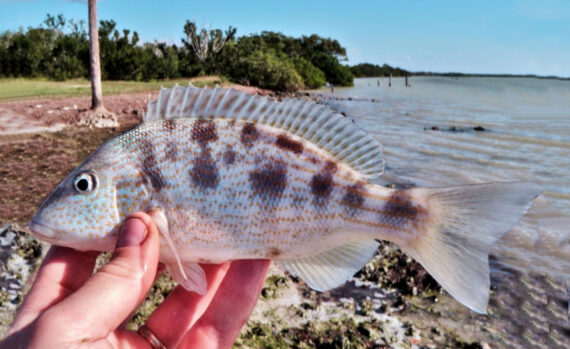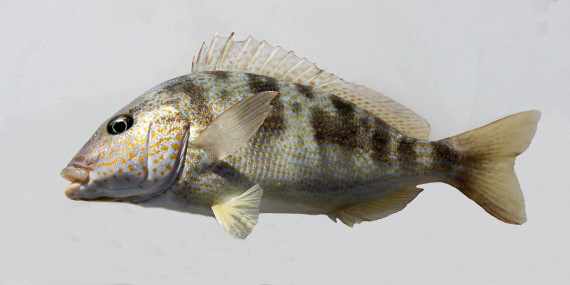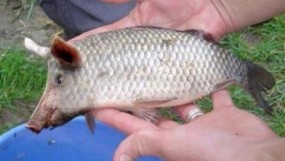Pigfish, Orthopristis chrysoptera
 Pigfish, Orthopristis chrysoptera, Juvenile. Fish caught from coastal waters off Tampa, Florida, May 2018. Length: 8.5 cm (3.3 inches). Catch, photograph and identification courtesy of Ben Cantrell, San Diego, California.
Pigfish, Orthopristis chrysoptera, Juvenile. Fish caught from coastal waters off Tampa, Florida, May 2018. Length: 8.5 cm (3.3 inches). Catch, photograph and identification courtesy of Ben Cantrell, San Diego, California.
 Pigfish, Orthopristis chrysoptera. Fish caught off a coastal pier in Morehead, North Carolina, October 2015. Length: 15 cm (5.9 inches). Catch, photograph and identification courtesy of Ben Cantrell, Peoria, Illinois.
Pigfish, Orthopristis chrysoptera. Fish caught off a coastal pier in Morehead, North Carolina, October 2015. Length: 15 cm (5.9 inches). Catch, photograph and identification courtesy of Ben Cantrell, Peoria, Illinois.
 Pigfish, Orthopristis chrysoptera. Fish caught off the Sanibel Fishing Pier, Sanibel, Florida, March 2017. Length: 15 cm (5.9 inches). Catch, photograph and identification courtesy of Marc Eberlein, Grand Rapids, Michigan.
Pigfish, Orthopristis chrysoptera. Fish caught off the Sanibel Fishing Pier, Sanibel, Florida, March 2017. Length: 15 cm (5.9 inches). Catch, photograph and identification courtesy of Marc Eberlein, Grand Rapids, Michigan.
 Pigfish, Orthopristis chrysoptera. Fish caught from coastal waters off Charleston, South Carolina. Length: 22 cm (8.7 inches). Catch, photograph, and identification courtesy of Josh Leisen (joshadventures.com), Gaylord, Michigan.
Pigfish, Orthopristis chrysoptera. Fish caught from coastal waters off Charleston, South Carolina. Length: 22 cm (8.7 inches). Catch, photograph, and identification courtesy of Josh Leisen (joshadventures.com), Gaylord, Michigan.
 Pigfish, Orthopristis chrysoptera. Fish caught from coastal waters off Key West, Florida, June 2015. Length: 25 cm (10 inches). Catch, photograph and identification courtesy of Dean Kimberly, Atlanta, Georgia.
Pigfish, Orthopristis chrysoptera. Fish caught from coastal waters off Key West, Florida, June 2015. Length: 25 cm (10 inches). Catch, photograph and identification courtesy of Dean Kimberly, Atlanta, Georgia.
The Pigfish, Orthopristis chrysoptera, is a member of the Grunt or Haemulidae Family, and is known in Mexico as corcoro armado. Globally, there are eight species in the genus Orthopristis, of which three are found in Mexican waters, one, this species, in the Atlantic Ocean and two in the Pacific Ocean.
The Pigfish has an elongated slender compressed body with a depth that is 34% to 38% of standard length. They are light blue dorsally and transition to silvery ventrally. Most fish have 8 wide black bars of varying lengths on their sides. Each body scale has a blue center and a bronze edge that form orange-brown stripes extending up and back along the sides. Their head has numerous small bronze spots and their dorsal fin has rows of bronze spots. They have a smoothly curved head profile with a short mouth that ends before the eyes and have thin lips and a band of slender teeth. Their anal fin has 3 spines, with the second being of equal size as the third, and 12 or 13 rays; their caudal fin is slightly forked; and, their dorsal fin is continuous without a notch and has 12 or 13 spines and 15 or 16 rays. They have 12 short slender gill rakers on their lower arch. They are covered with small scales.
The Pigfish is a demersal inshore species that is found over soft bottoms, including estuaries, within grass flats, and around bars and along channel edges, at depths up to 104 m (340 feet). They reach a maximum of 46 cm (18 inches) in length but are typically in the 15 cm (6 inches) to 20 cm (8 inches) range. As of January 1, 2024, the International Game Fish Association world record stood at 2.12 kg (1 lb 12 oz) with the fish caught in coastal waters off North Carolina in May 2016. They are nocturnal carnivores feeding on benthic crustaceans, mollusks, echinoderms, and small fish. The Pigfish is poorly studied with very limited information available about their lifestyle and behavioral patterns including specific details on age, growth, longevity, movement patterns, diet, habitat use, and reproduction.
The Pigfish is a resident of all Mexican waters of the Atlantic Ocean with the exception they are absent from along the east coast of the Yucatán in the Caribbean.
The Pigfish is most likely confused with the Margate, Haemulon album (dark caudal fin), the White Grunt, Haemulon plumierii (yellow and blue stripes on head) and possibly the Snouted Pigfish, Haemulon hoax (pictured below).
From a conservation perspective the Pigfish is currently considered to be of Least Concern with stable, widely distributed populations. They are actively pursued by recreational anglers utilizing cane pole or light spinning gear with small hooks and cut bait or shrimp. They are often a by-catch of Seatrout fishermen taken off of grass flats, but are also a common catch off docks and bridges all along the Gulf Coast of the United States. Although small in stature, they are considered to be an excellent panfish. Smaller ones are also used as a live bait targeting Seatrout.
